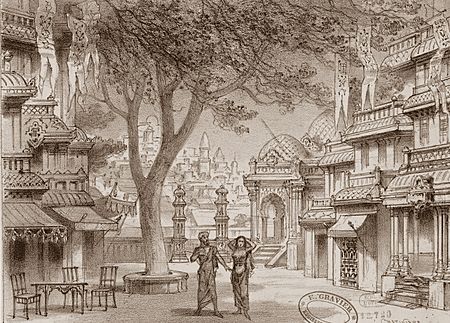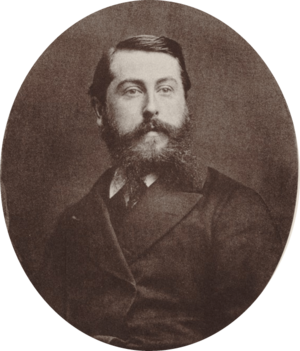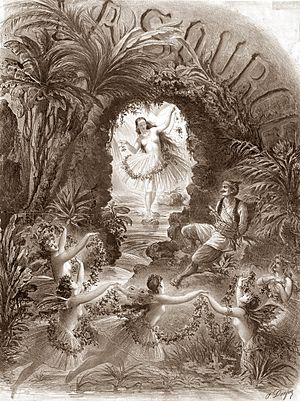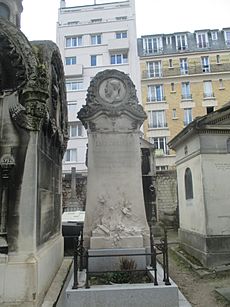Léo Delibes facts for kids
Clément Philibert Léo Delibes (French: [klemɑ̃ filibɛʁ leo dəlib]; February 21, 1836 – January 16, 1891) was a French composer. He is famous for his ballets and operas. His most well-known works include the ballets Coppélia (1870) and Sylvia (1876). He also wrote the opera Lakmé (1883), which features the famous "Flower Duet".
Delibes came from a musical family. He joined the Conservatoire de Paris, a top music school, when he was twelve. He studied with famous teachers like Adolphe Adam. In the 1850s and 1860s, he wrote light comic operas called opérettes. He also worked as a church organist.
He became well-known for his music for the ballet La Source in 1866. His later ballets, Coppélia and Sylvia, were very important. They made ballet music much more significant than before. Delibes also composed some songs called mélodies. Some of these are still performed today.
Delibes tried writing more serious operas. He had great success in 1883 with Lakmé. Later in his life, he taught composition at the Conservatoire. He passed away in Paris at age 54. Coppélia and Sylvia are still popular ballets worldwide. Lakmé is also performed in opera houses sometimes.
Contents
Life and Music Journey
Growing Up and Learning Music
Delibes was born in a town called La Flèche, France, on February 21, 1836. His father worked for the postal service. His mother loved music and was very talented. Her father was an opera singer, and her uncle was a church organist. Léo was their only child.
His father died in 1847. After that, his family moved to Paris. Soon after his twelfth birthday, Delibes was accepted into the Conservatoire de Paris. He studied music theory, piano, organ, and harmony. When he was eighteen, he studied composition with Adolphe Adam.
As a boy, Delibes had a beautiful singing voice. He sang in the choir at a church called La Madeleine. He also sang in the first performance of Meyerbeer's Le prophète at the Paris Opera in 1849. While still a student, Delibes became an organist at a church. He also worked as an accompanist at the Théâtre Lyrique. There, he helped prepare many operas. These included famous ones like The Marriage of Figaro and Fidelio.
Becoming a Composer
In 1856, Delibes' first stage work was shown. It was a short comic piece called Deux sous de charbon. For the next fourteen years, he wrote more comic operas. He wrote about one each year. Many of these were for the Bouffes-Parisiens theater. This theater was run by Jacques Offenbach. One of his early operas, Deux vieilles gardes, was very popular. People loved his witty melodies and light style.
Besides composing, Delibes also worked as a music critic for a short time. He was also an inspector of school music. From 1862, he worked as an accompanist and later a chorus master at the Paris Opéra. This job led him to compose ballet music. In 1866, he was asked to write two acts of the ballet La Source. Another composer, Ludwig Minkus, wrote the other two acts. Critics said Delibes' music was so rich and beautiful that it outshone Minkus's part.
After this success, Delibes was asked to compose a dance piece. It was called Le Pas de Fleurs. This piece was added to a ballet by his former teacher, Adam.
In 1870, Delibes became widely known for his music for the ballet Coppélia. It was first performed at the Opéra in May 1870. It was an instant hit. Coppélia is still one of the most loved classical ballets. The next year, he left his job at the Opéra. He decided to focus only on composing. In that year, he married Léontine Estelle Denain.
Delibes wanted to write more than just ballets. So, he started writing mélodies (songs). In 1872, he released a collection of songs. These included "Myrto" and "Les Filles de Cadiz". In 1873, he wrote a comic opera called Le Roi l'a dit. Critics praised Delibes' music for its melodies and good taste. The opera was a success in Paris and Germany.
Delibes returned to the Opéra in 1876 with a grand ballet called Sylvia. This ballet confirmed his skill in dance music. It was very popular with both critics and the public. In 1877, Delibes was honored with the Legion of Honour.
Despite his ballet successes, Delibes still wanted to write serious vocal works. He composed a large piece called La Mort d'Orphée in 1878. He then wrote a serious opera, Jean de Nivelle, in 1880. Critics liked his melodies and delicate style. One critic even called it "the best opera" since Bizet's Carmen. The opera was performed over a hundred times.
Later Years and Legacy
In 1881, Delibes became a professor of composition at the Conservatoire. He took his teaching duties very seriously. He cared deeply about his students' success. In 1882, Delibes wrote music for a play by Victor Hugo. It included old-style dances and a song.
Delibes' most famous opera, Lakmé, premiered on April 14, 1883. The manager of the Opéra-Comique, Léon Carvalho, made sure it was a very grand production.
Lakmé quickly became popular across Europe. It was performed in London in 1885 and New York in 1886. Reviews in America were very positive. The opera did well at the box office in both cities.
Delibes' last years were comfortable. He had enough money and was well-respected. In 1884, he was elected to the Institut de France. His last work was another opera, Kassya. It was not finished when he died. Delibes had been sick for some time. He passed away suddenly in Paris, just before his 55th birthday. He was buried in the Cimetière de Montmartre in Paris.
Delibes' Music Style
Delibes' early music was influenced by composers like Boieldieu and Adolphe Adam. Adam was his composition teacher. From him, Delibes learned a "sparkling operetta style." Later, he wanted to write more serious music. His works then showed influences from Meyerbeer and Gounod. Critics often used words like "wit," "charm," "elegance," and "lightness" to describe his early music. Many believed he was the most "characteristically French" composer of his time.
Operas
Le Roi l'a dit is a light opera. It has many detailed group singing parts and witty musical jokes. Jean de Nivelle is more serious. It shows the influence of Meyerbeer. It has a heavier feel, but sometimes uses Delibes' lighter style. For example, in one part, the chorus switches between different rhythms.

Lakmé is often considered Delibes' greatest work. It shows the influence of Bizet. You can hear echoes of Bizet's operas like Carmen in its harmonies and orchestration. The opera is known for its beautiful music. The main characters, Nilakantha and Gérald, are also well-developed. Lakmé is still performed occasionally around the world.
Delibes' last opera, Kassya, was almost finished when he died. Another composer, Jules Massenet, completed it. It premiered two years after Delibes' death. People respected it, but felt it showed his creative gifts were declining. It had twelve performances.
Ballets
Coppélia was influenced by Adam. It uses special musical themes called leitmotifs for characters and moods. Delibes used these themes a lot. Each main character has music that describes them. For example, Swanilda's music is bright and graceful. Dr. Coppélius's music is stiff and dry. Delibes also used many national dances. These included the bolero, czardas, and mazurka. He mixed them with waltz rhythms.
Many critics believe the music for Sylvia is even better than Coppélia. The composer Pyotr Ilyich Tchaikovsky thought Delibes changed ballet music forever. Before Delibes, ballet music was often simple. Delibes brought a more symphonic style to ballet. He added rich melodies and harmonies. This made ballet music much more important. Some say Delibes' ballet scores paved the way for 20th-century ballets. These include works by Debussy and Stravinsky.
After Sylvia, Delibes wrote only one more dance piece. It was a suite of six dances for a play. These dances were in an old-fashioned style. They showed his skill in creating music that fit a specific time period. They are not often played in concerts today.
Songs (Mélodies)
Delibes' songs are often described as light and entertaining. They are different from the more serious German songs called lieder. In his songs, Delibes showed a natural feel for theater. He could also create a sense of place, like in his Spanish song "Les filles de Cadiz." Some of his early songs, like "Eclogue" and "Bonjour, Suzon," are charming and delicate.
Some of his songs sound like music from the 16th century. Examples include "Avril" and "Myrto." Delibes was better at expressing calm feelings than strong passions in his songs. He is often compared to Reynaldo Hahn. Both composers aimed to give pleasure with their music.
See also
 In Spanish: Léo Delibes para niños
In Spanish: Léo Delibes para niños





